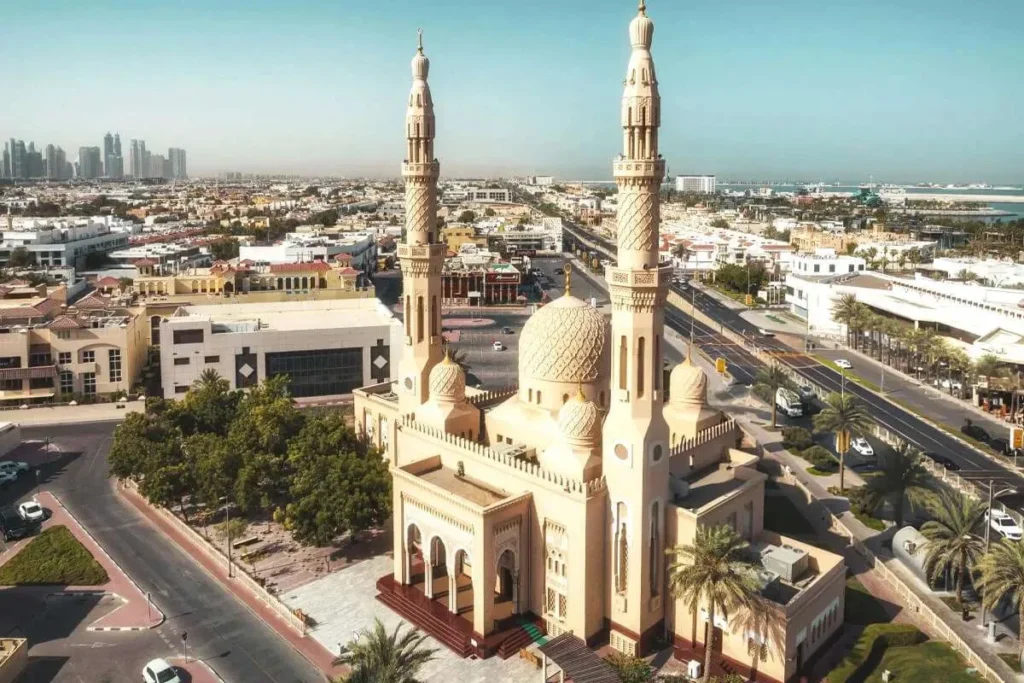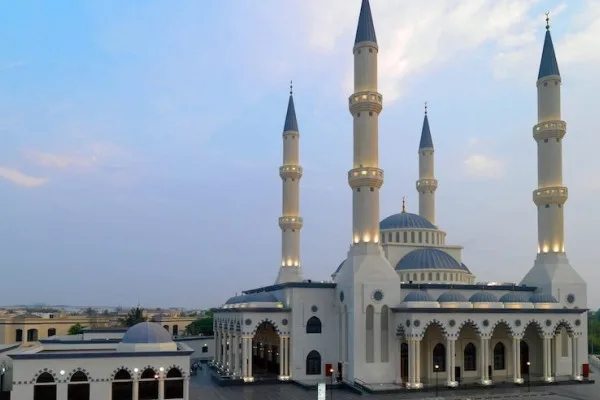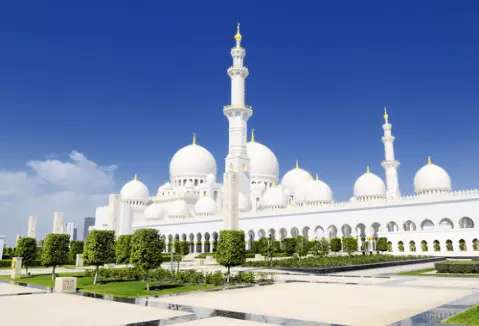Dubai’s mosques represent both spiritual centers and architectural masterpieces, blending traditional Islamic design with contemporary elements. While the city is home to hundreds of mosques, only certain ones welcome non-Muslim visitors, offering a unique opportunity to appreciate Islamic architecture and learn about the faith in a respectful environment.
Mosques Open to Non-Muslim Visitors
Jumeirah Mosque

Jumeirah Mosque stands as Dubai’s most accessible and welcoming mosque for tourists, regardless of their faith. Built in 1979 in the medieval Fatimid style, this stone structure features twin minarets and a large central dome that creates a striking silhouette against Dubai’s skyline.
What Makes It Special
The mosque’s beauty emerges particularly during evening hours when external lighting illuminates the cream-colored stone facade, creating a warm glow visible along Jumeirah Beach Road. The architectural details—from carved wooden doors to intricate calligraphy—showcase traditional Islamic artistry.
Beyond its aesthetic appeal, Jumeirah Mosque operates the “Open Doors, Open Minds” program, specifically designed to bridge cultural understanding. These guided tours allow visitors to enter the prayer hall, ask questions about Islam, and observe the mosque’s interior design up close.
Visiting Information
Tours run multiple times throughout the week, typically in the morning. Reservations are strongly recommended as spaces fill quickly, especially during peak tourist season (November through March).
During the tour, guides explain Islamic practices, the significance of architectural elements, and answer questions in an open, educational environment. The experience lasts approximately 75 minutes.
Dress Code: Modest clothing covering arms and legs is required. Women receive abayas (traditional robes) and headscarves at entry if needed. Men should wear long pants and shirts covering shoulders.
Photography: Allowed and encouraged. The mosque’s interior and exterior provide excellent photo opportunities, particularly the mihrab (prayer niche) and the dome’s interior geometric patterns.
Location: Jumeirah Beach Road, near Dubai Zoo
Best Timing: Morning tours to avoid afternoon heat
Cost: Small fee for the tour program (typically AED 35-50)
Al Farooq Omar Bin Al Khattab Mosque

This relatively modern mosque, opened in 2011, draws inspiration from Istanbul’s famous Blue Mosque with its Ottoman architectural style. Located in Al Safa area, it features multiple minarets, cascading domes, and a spacious courtyard.
Architectural Highlights
The Ottoman influence distinguishes Al Farooq from other Dubai mosques. The design incorporates elements typically associated with Turkish mosque architecture—pointed arches, pencil-shaped minarets, and a hierarchical arrangement of domes surrounding a prominent central dome.
The interior showcases traditional Islamic geometric patterns, Arabic calligraphy, and a large prayer hall accommodating thousands of worshippers. The attention to detail in tilework and carved elements reflects the craftsmanship associated with historical Ottoman mosques.
Visitor Experience
Al Farooq Mosque also participates in cultural exchange programs, offering guided tours that explain Islamic architecture, religious practices, and the mosque’s community role. The tours provide insight into how contemporary mosques serve both spiritual and social functions in Dubai’s diverse community.
Visiting Information
Tours are available but less frequent than at Jumeirah Mosque. Checking ahead for current tour schedules ensures you can plan your visit appropriately.
Location: Al Safa area, between Al Wasl and Sheikh Zayed Road
Best for: Architecture enthusiasts, photography, understanding Ottoman mosque design
Accessibility: Easy reach from most Dubai neighborhoods
Significant Mosques (External Viewing)
While the following mosques don’t typically offer public tours for non-Muslims, their architectural significance and locations make them worthwhile for external viewing and photography.
Grand Bur Dubai Mosque (Grand Mosque)

Often called simply “Grand Mosque,” the Grand Bur Dubai Mosque represents Dubai’s largest mosque, with capacity for over 1,200 worshippers. Located in the historic Bur Dubai area near the Creek, this mosque features a distinctive tall minaret that serves as a local landmark.
Architectural Significance
The mosque’s design follows traditional Gulf architectural patterns with its large central dome and prominent minaret. The cream and sand-colored stone creates visual harmony with the surrounding historic district.
The mosque’s size and central location in old Dubai make it a community focal point. Its proximity to the textile souq, spice souq, and historic neighborhoods means you’ll likely pass it while exploring traditional Dubai.
Viewing Opportunities
While non-Muslim entry isn’t typically permitted, the exterior offers excellent photography opportunities. The surrounding area—part of Dubai’s oldest neighborhood—provides context for understanding the mosque’s role in the community’s daily life.
The creek-side location means you can photograph the mosque from various angles, including from abra (traditional water taxi) rides across the creek.
Location: Bur Dubai, near the Creek and traditional souqs
Best Time: Early morning or evening for best lighting
Nearby Attractions: Dubai Museum, Al Fahidi Historical District, textile and spice souqs
Zabeel Mosque
This striking modern mosque near Za’abeel Palace features contemporary Islamic architecture with a massive illuminated dome. The mosque’s white facade and dramatic lighting make it particularly photogenic during evening hours.
Design Elements
Zabeel Mosque represents contemporary mosque architecture, incorporating traditional elements like minarets and domes with modern construction techniques and materials. The result is a structure that honors Islamic architectural heritage while embracing contemporary aesthetics.
The mosque’s illumination system creates a spectacular nighttime display, with the dome glowing against the dark sky—a favorite subject for photographers.
Location: Za’abeel area, visible from Sheikh Zayed Road
Photography: External photography from public areas is acceptable
Best Viewing: Evening hours when illuminated
Ras Al Khor Mosque
Located in the Ras Al Khor area, this mosque’s minarets create a striking contrast with the nearby flamingo sanctuary and industrial area. The juxtaposition of natural environment, religious architecture, and urban development represents Dubai’s unique character.
Location Context
The mosque sits near Ras Al Khor Wildlife Sanctuary, where flamingos gather, creating unusual photograph opportunities combining Islamic architecture with natural wildlife. This area offers a different perspective on Dubai—away from glittering skyscrapers and shopping malls.
Location: Ras Al Khor area
Best Combined With: Flamingo viewing at the nearby sanctuary
Photography: Beautiful sunrise and sunset shots possible
Understanding Mosque Architecture
Appreciating mosque architecture enhances your visiting experience. Key elements include:
Minarets
These towers, from which the call to prayer (adhan) traditionally sounded, vary in number and style. Dubai mosques typically feature one to four minarets, with design ranging from traditional Gulf style to Ottoman-influenced pencil shapes.
Domes
Central domes cover the main prayer hall, often surrounded by smaller domes creating a hierarchical arrangement. The interior of domes frequently features geometric patterns or calligraphy.
Mihrab
This niche in the qibla wall (the wall facing Mecca) indicates the prayer direction. Mihrabs often feature the most elaborate decorative work, with intricate tilework or carved stone.
Minbar
The pulpit from which the imam delivers Friday sermons. Traditional minbars feature ornate woodwork or carved stone.
Calligraphy
Arabic calligraphy adorning walls typically includes Quranic verses or names of Allah and the Prophet Muhammad. The calligraphy serves both decorative and spiritual purposes.
Geometric Patterns
Islamic art traditionally avoids depicting living beings, instead using complex geometric patterns that symbolize infinity and the divine order of creation.
Visiting Sheikh Zayed Grand Mosque (Abu Dhabi)
While technically during Abu Dhabi tour rather than Dubai, the Sheikh Zayed Grand Mosque deserves mention as the UAE’s most magnificent mosque and a essential destination for anyone interested in Islamic architecture.
Why It Matters
This mosque represents one of the world’s largest and most beautiful, accommodating over 40,000 worshippers. The architecture combines elements from various Islamic traditions—Moroccan, Egyptian, Turkish, and Moorish influences create a synthesis of Islamic architectural history.
Visitor Experience
The mosque welcomes non-Muslim visitors daily (except during prayer times and special religious occasions) with free entry. The vast complex includes:
- 82 domes of varying sizes
- Four minarets reaching 107 meters
- The world’s largest hand-knotted carpet
- Massive chandeliers incorporating Swarovski crystals
- Reflective pools creating mirror images
Guided tours are available, or visitors can explore independently with audio guides. The experience is more extensive than Dubai’s mosque tours, requiring 1.5-2 hours to appreciate fully.
Practical Information
Location: Abu Dhabi (45-60 minutes from Dubai)
Cost: Free entry
Hours: Open daily with specific visiting hours (closed during prayer times)
Dress Code: Strictly enforced—full coverage required, abayas and headscarves provided for women
Photography: Allowed in most areas
Many visitors combine Dubai trips with a day excursion to Abu Dhabi specifically to visit this mosque.
Practical Guide for Visiting Mosques
Dress Code Requirements
All mosques require modest dress:
For Women:
- Full arm coverage (sleeves to wrists)
- Full leg coverage (long pants or skirts to ankles)
- Headscarf covering hair
- Loose-fitting clothing (nothing tight or form-revealing)
- Abayas often provided at tourist-friendly mosques
Men:
- Long pants (no shorts)
- Shirts covering shoulders and arms (short sleeves acceptable at some locations)
- No tank tops or sleeveless shirts
For Everyone:
- Shoes removed before entering prayer areas
- Clean socks recommended (you’ll be walking in socks or barefoot)
- Avoid clothing with offensive imagery or text
Behavioral Etiquette
Inside Mosques:
- Speak quietly and respectfully
- Don’t walk in front of people who are praying
- Don’t touch religious items or texts without permission
- Follow guide instructions regarding where visitors can walk
- Turn off phone ringers
- Don’t eat, drink, or chew gum inside prayer halls
Photography:
- Ask permission before photographing people
- Avoid photographing people during prayer
- Flash photography may be restricted in some areas
- Follow any posted photography restrictions
- Be especially respectful when photographing women
Best Times to Visit
Avoid Prayer Times: Mosques close to non-Muslim visitors during the five daily prayers and Friday congregational prayers. Prayer times vary with sunrise/sunset, so check current times before visiting.
Optimal Visiting Windows:
- Late morning (9:00 AM – 11:00 AM)
- Mid-afternoon (2:00 PM – 4:00 PM)
- Early evening for exterior photography
Seasonal Considerations: November through March offers the most comfortable temperatures for walking around mosques and exploring surrounding neighborhoods. Summer months (June-September) require visiting during cooler morning hours.
Ramadan: During the holy month, mosque visiting policies may change. Some tours continue but with modified schedules, while others pause. The spiritual atmosphere during Ramadan is unique, but confirm visiting policies beforehand. Check desert safari Dubai prices.
Photography Tips
Exterior Shots:
- Golden hour (shortly after sunrise or before sunset) provides beautiful warm lighting
- Blue hour (just after sunset) captures illuminated mosques against twilight sky
- Overcast days reduce harsh shadows and can improve stone facade photography
- Include surrounding context (gardens, water features, urban setting) for environmental shots
Interior Photography (where permitted):
- Mosques are often dim inside—use high ISO or long exposures
- Tripods may not be allowed during tours
- Wide-angle lenses capture dome interiors and prayer hall scale
- Detail shots of calligraphy, geometric patterns, and architectural elements
- Natural light from windows creates beautiful effects
Planning Your Mosque Visit
Time Allocation:
- Jumeirah Mosque guided tour: 1.5 hours
- Independent mosque exterior viewing: 20-30 minutes each
- Sheikh Zayed Grand Mosque (Abu Dhabi): 2-3 hours
Combining Attractions: Mosques near other Dubai attractions allow efficient sightseeing:
- Grand Bur Dubai Mosque + Dubai Museum + Souqs + Al Fahidi District = Historical Dubai Day
- Jumeirah Mosque + Jumeirah Beach + La Mer = Coastal Dubai Afternoon
- Multiple mosques + photography focus = Architectural Tour
Booking and Preparation:
- Book Jumeirah Mosque tours in advance through their website
- Check current prayer times before departure
- Bring modest clothing or prepare to use provided garments
- Carry a bag for shoes (you’ll remove them)
- Bring water (desert climate requires hydration)
Cultural Sensitivity and Respect
Visiting mosques as a non-Muslim requires particular cultural awareness:
Understanding Context: For Muslims, mosques are sacred spaces central to faith practice. While cultural tourism is welcomed at designated mosques, maintaining respectful behavior honors these spaces’ spiritual significance.
Learning Opportunity: Tours at Jumeirah Mosque specifically encourage questions about Islam. Use this opportunity to learn about religious practices, beliefs, and mosque significance in Muslim life.
Avoiding Stereotypes: Approach mosque visits with openness. These experiences help counter stereotypes and build understanding between cultures and faiths.
Supporting Cultural Exchange: By visiting respectfully and engaging genuinely with guides and information provided, tourists support the “Open Doors, Open Minds” philosophy that makes these experiences possible.
Beyond the Main Mosques
While the mosques mentioned above represent Dubai’s most significant or accessible examples, the city contains hundreds of neighborhood mosques that contribute to the urban fabric.
Neighborhood Mosques: Walking through residential areas, you’ll notice small local mosques serving communities. While these don’t offer tours, observing them provides insight into Islam’s role in daily life.
Modern Mosque Architecture: Newer Dubai neighborhoods feature contemporary mosque designs incorporating modern materials while respecting traditional forms. These represent how Islamic architecture evolves within contemporary contexts.
Community Role: Mosques function beyond worship spaces—they serve as community centers, education facilities, and social gathering points. Understanding this broader role enriches appreciation of their significance.
Creating Your Mosque Visiting Itinerary
Option 1: Cultural Deep Dive
- Morning: Jumeirah Mosque guided tour
- Afternoon: Grand Bur Dubai Mosque exterior viewing + surrounding historical area exploration
- Evening: Zabeel Mosque illuminated photography
2nd Option: Architectural Photography Focus
- Early morning: Grand Bur Dubai Mosque in sunrise light
- Late morning: Jumeirah Mosque exterior and surrounding area
- Sunset: Al Farooq Mosque or Zabeel Mosque for golden hour shots
- Evening: Illuminated mosque photography
Option 3: Dubai-Abu Dhabi Mosque Tour
- Morning: Drive to Abu Dhabi
- Mid-morning to afternoon: Sheikh Zayed Grand Mosque extensive visit
- Evening return: Stop at Jumeirah Mosque for exterior evening photography
Option 4: Historical Context Tour
- Grand Bur Dubai Mosque
- Al Fahidi Historical District
- Dubai Museum
- Traditional souqs
- Heritage Village
- (Combining mosque visit with understanding Dubai’s history





